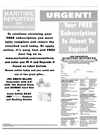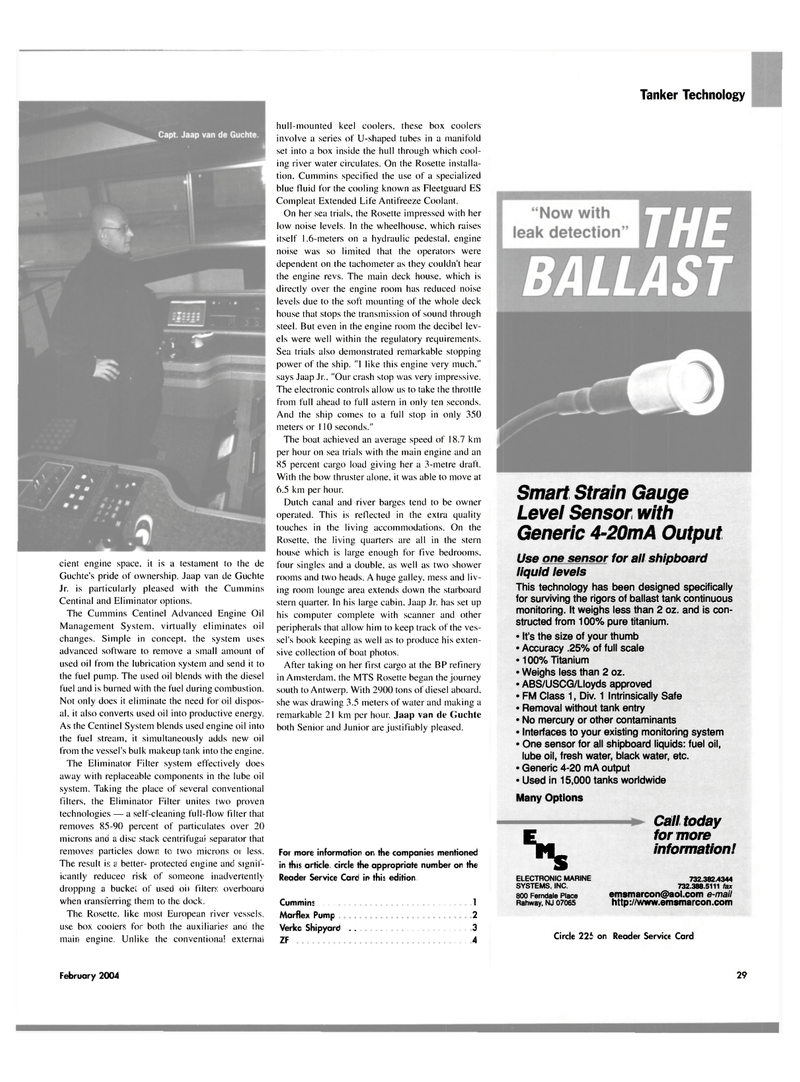
Page 34: of Maritime Reporter Magazine (February 2004)
The Tanker Yearbook: ATB Edition
Read this page in Pdf, Flash or Html5 edition of February 2004 Maritime Reporter Magazine
Tanker Technology cient engine space, it is a testament to the de
Guchte's pride of ownership. Jaap van de Guchte
Jr. is particularly pleased with the Cummins
Centinal and Eliminator options.
The Cummins Centinel Advanced Engine Oil
Management System, virtually eliminates oil changes. Simple in concept, the system uses advanced software to remove a small amount of used oil from the lubrication system and send it to the fuel pump. The used oil blends with the diesel fuel and is burned with the fuel during combustion.
Not only does it eliminate the need for oil dispos- al, it also converts used oil into productive energy.
As the Centinel System blends used engine oil into the fuel stream, it simultaneously adds new oil from the vessel's bulk makeup tank into the engine.
The Eliminator Filter system effectively does away with replaceable components in the lube oil system. Taking the place of several conventional filters, the Eliminator Filter unites two proven technologies — a self-cleaning full-flow filter that removes 85-90 percent of particulates over 20 microns and a disc stack centrifugal separator that removes particles down to two microns 01 less.
The result is a better- protected engine and signif- icantly reducec risk of someone inadvertently dropping a bucket of used oil filters overboard when transferring them to the dock.
The Rosette like most European river vessels, use box coolers for both the auxiliaries and the main engine. Unlike the conventional external hull-mounted keel coolers, these box coolers involve a series of U-shaped tubes in a manifold set into a box inside the hull through which cool- ing river water circulates. On the Rosette installa- tion. Cummins specified the use of a specialized blue fluid for the cooling known as Fleetguard ES
Compleat Extended Life Antifreeze Coolant.
On her sea trials, the Rosette impressed with her low noise levels. In the wheelhouse, which raises itself 1.6-meters on a hydraulic pedestal, engine noise was so limited that the operators were dependent on the tachometer as they couldn't hear the engine revs. The main deck house, which is directly over the engine room has reduced noise levels due to the soft mounting of the whole deck house that stops the transmission of sound through steel. But even in the engine room the decibel lev- els were well within the regulatory requirements.
Sea trials also demonstrated remarkable stopping power of the ship. "I like this engine very much," says Jaap Jr., "Our crash stop was very impressive.
The electronic controls allow us to take the throttle from full ahead to full astern in only ten seconds.
And the ship comes to a full stop in only 350 meters or 110 seconds."
The boat achieved an average speed of 18.7 km per hour on sea trials with the main engine and an 85 percent cargo load giving her a 3-metre draft.
With the bow thruster alone, it was able to move at 6.5 km per hour.
Dutch canal and river barges tend to be owner operated. This is reflected in the extra quality touches in the living accommodations. On the
Rosette, the living quarters are all in the stern house which is large enough for five bedrooms, four singles and a double, as well as two shower rooms and two heads. A huge galley, mess and liv- ing room lounge area extends down the starboard stern quarter. In his large cabin. Jaap Jr. has set up his computer complete with scanner and other peripherals that allow him to keep track of the ves- sel's book keeping as well as to produce his exten- sive collection of boat photos.
After taking on her first cargo at the BP refinery in Amsterdam, the MTS Rosette began the journey south to Antwerp. With 2900 tons of diesel aboard, she was drawing 3.5 meters of water and making a remarkable 21 km per hour. Jaap van de Guchte both Senior and Junior are justifiably pleased.
Foi more information or, the companies mentioned in this article circle the appropriate number or the
Reader Service Card ir this edition
Cummins .1
Marflex Pump 2
Verkc Shipyard ... .3
ZF 4
Smart Strain Gauge
Level Sensor with
Generic 4-20mA Output
Use one sensor for all shipboard liquid levels
This technology has been designed specifically for surviving the rigors of ballast tank continuous monitoring. It weighs less than 2 oz. and is con- structed from 100% pure titanium. • It's the size of your thumb • Accuracy .25% of full scale • 100% Titanium • Weighs less than 2 oz. • ABS/USCG/Lloyds approved • FM Class 1, Div. 1 Intrinsically Safe • Removal without tank entry • No mercury or other contaminants • Interfaces to your existing monitoring system • One sensor for all shipboard liquids: fuel oil, lube oil, fresh water, black water, etc. • Generic 4-20 mA output • Used in 15,000 tanks worldwide
Many Options
S
ELECTRONIC MARINE
SYSTEMS. INC. 800 Ferndale Place
Rahway, NJ 07065
Call today for more information! 732.382.4344 732.388.5111 fax [email protected] e-mail http ://www.emsmarcon .com
Circle 22i on Reader Service Card
February 2004 29

 33
33

 35
35
